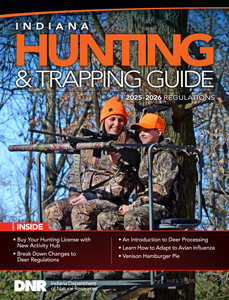Furbearer Trapping
Trapping Seasons |
|
Species |
Trapping Seasons |
Red & Gray Fox |
Oct. 15 - Jan. 31 |
Coyote & Striped Skunk |
Oct. 15 - March 15 |
Raccoon & Opossum |
Nov. 8 - Jan. 31 |
Mink, Muskrat, Long-tailed Weasel |
Nov. 15 - Jan. 31 |
Beaver |
Nov. 15 - March 15 |
River Otter |
Nov. 15 - March 15 (or until quota is met) |
Bobcat (in designated counties) |
Nov. 8 - Jan. 31 (or until quota is met) |
Trapping Regulations
Furbearing game animals in Indiana include beaver, bobcat, coyote, gray fox, red fox, long-tailed weasel, mink, muskrat, opossum, raccoon, river otter, and striped skunk.
You must have a valid Indiana trapping license to set traps.
Traps must be checked and animals removed at least once every 24 hours with the following exception: Traps that are designed to capture and kill the animal as a result of submerging the animal in water or crushing or asphyxiating the animal must be checked at least once every 48 hours. The DNR recommends checking every trap within 24 hours.
Traps may be set at any distance from openings to tile drains or entrances to beaver or muskrat lodges. Tree-climbing equipment may not be used as an aid in removing wild animals from trees. The use of motor-driven watercraft is permitted for purposes of setting or checking trap lines.
River Otter Rules
A valid Indiana trapping license is required to set traps for river otters. An individual who sets a trap for river otters must be at least 10 years old, unless the individual has passed a state-certified trapper education course.
River otter harvest is trapping only, no hunting is allowed. The bag limit is two otters per trapper per season. An individual who sets a trap that catches a river otter must count the animal toward their season limit. All river otters harvested during trapping season must be reported to the DNR CheckIN Game system within 24 hours of harvest. Reports can be submitted online through the Go Outdoors Indiana website or by calling 260-368-5880. A CheckIN Game confirmation number will be provided and must be kept with the river otter until the animal is physically registered by a designated Indiana DNR employee or at an official DNR furbearer check station. Check the Indiana DNR Otter Trapping page for a list of approved trapping locations and zone information.
There is a season quota of 750 river otters for the 2025-2026 season. The season will close early if the quota is reached prior to March 15, 2026. Trappers are responsible for knowing if the quota has been met. View the current reported river otter harvest totals on the Indiana DNR Otter Trapping page or by calling 317-232-4200 for the latest updates. If the season closes early, an exception may be made for an individual who traps a river otter within 48 hours after the close of the season and has not yet reached their bag limit.
You must take the skinned carcass and separated pelt to a designated DNR employee or registration station for physical registration and CITES tagging within 15 days after the month of harvest.
River otter pelts will be sealed with a CITES tag and the carcass collected so DNR biologists can evaluate reproductive and age data from the animal. The information is critical to the population model, allowing the DNR to set quotas and bag limits effectively.
Individuals who kill river otters during the season but after the statewide quota has been met, after they have reached their bag limit or outside the season must notify the DNR within 48 hours of capture and make arrangements for the DNR to take the carcass. Call your local DNR District Wildlife Biologist (see DNR Wildlife Biologists), local DNR Conservation Officer (see DNR Law Enforcement), or Law Enforcement Central Dispatch at 812-837-9536.
What is a CITES tag?
CITES stands for the Convention on International Trade in Endangered Species of Wild Fauna and Flora. It is an international agreement governing trade of endangered species. As a CITES participant, the United States follows certain requirements. River otters and bobcats are in Appendix II of CITES. These species are “look-alikes” to other endangered species around the world, such as the Iberian lynx or Asian small-clawed otter. To ensure river otters and bobcats entering international trade were harvested legally in the United States, an unaltered CITES tag must be affixed to the pelt while it is in raw, untanned form. Each state has uniquely marked tags. An otter or bobcat pelt must have a CITES tag before it can be sold.
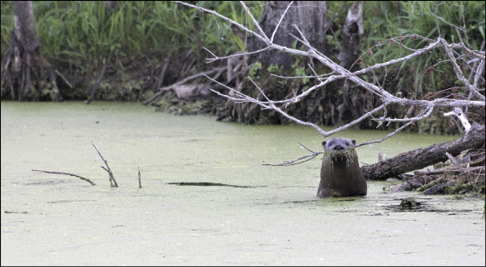
Bobcat Rules
A valid Indiana bobcat license is required to set traps for and harvest a bobcat. Lifetime trapping licenses, resident youth hunting and trapping combo licenses, and nonresident youth bobcat licenses may also be used to set traps for and harvest a bobcat. Youth apprentice hunting licenses are not valid for bobcat trapping. The bobcat season is trapping-only, no hunting is currently allowed. A valid trapping license is required to set traps for any species, including bobcats. The bobcat season runs from November 8, 2025, until January 31, 2026, or until the season quota is met. Only foothold, cage, and cable devices (e.g., snares) may be used. Bobcat trapping is limited to certain counties (see map below).
Counties Open to Bobcat Trapping
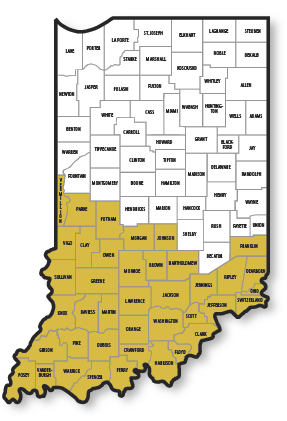
The bag limit is one bobcat per trapper per season. An individual who sets a trap that catches and kills a bobcat must count the animal toward their season limit. All bobcats harvested during trapping season must be reported to the DNR CheckIN Game system within 24 hours of harvest. Reports can be submitted online through the Go Outdoors Indiana website or by calling 260-368-5880. A CheckIN Game confirmation number will be provided and must be kept with the bobcat until the animal is physically registered by a designated Indiana DNR employee or at an official DNR furbearer check station. Visit the Indiana DNR Bobcat Season page to view approved trapping locations, regulations, and harvest information.
There is a season quota of 250 bobcats for 2025-2026. The season will close early if the quota is reached prior to January 31, 2026. Trappers are responsible for knowing if the quota has been met.
View the most recent bobcat harvest totals and season updates on the Indiana DNR Bobcat Season page or call 317-232-4200 for current information.
You must take the skinned and separated pelt to a designated DNR employee or furbearer registration station for physical registration and CITES tagging within 15 days after the month of harvest. Locate official furbearer registration stations by visiting the Indiana DNR Bobcat Season page.
Bobcat pelts will be sealed with a CITES tag. Bobcat carcasses are not required to be turned in to DNR at this time. The Indiana DNR has a habitat-based population model for bobcats, as opposed to the age-at-harvest model used for river otters that requires carcass submission.
Individuals who kill a bobcat after the season quota has been met, after they have reached their bag limit, or outside the season must notify the DNR within 24 hours of capture and make arrangements for the DNR to take the bobcat. Call your local DNR District Wildlife Biologist (see DNR Wildlife Biologists), local DNR Conservation Officer (see DNR Law Enforcement), or DNR Law Enforcement Central Dispatch at 812-837-9536.
Wildlife Conflicts
Resident landowners or tenants may use legal methods, without a permit, to take a beaver, mink, muskrat, long-tailed weasel, red fox, gray fox, opossum, skunk, gray squirrel, fox squirrel, or raccoon that is on their own property and damaging property or posing a health or safety threat.
If the animal is released, it must be released in the county of capture with the permission of the recipient landowner.
Groundhogs (woodchucks), moles, voles, red squirrels, and chipmunks may be taken at any time using any equipment without a permit.
Landowners may take coyotes at any time on the land they own without a special permit or license, or they may provide written permission for others to take coyotes on their land at any time. A valid hunting or trapping license or nuisance wild animal control permit is required to take a coyote on land other than your own.
Coyotes that are taken outside the hunting and trapping season by a landowner or someone with written permission from a landowner cannot be possessed live for more than 24 hours, and the live coyote cannot be sold, traded, bartered, or gifted.
For assistance with wildlife conflicts, contact your District Wildlife Biologist (see DNR Wildlife Biologists).
Body Gripping Traps
A person must not take a wild animal with a Conibear, Dahlgren, Bigelow, or other body-gripping trap on land if the widest inside jaw-spread measured at the horizontal center of the trap’s jaws (Figure 1) and the widest horizontal inside jaw-spread measured at the vertical center of the trap’s jaws (Figure 2) is:
- Larger than 7.5 inches if square or
- Larger than 8 inches if round
Otherwise, when set, at least 50% of the opening of the trap must be submerged in water.
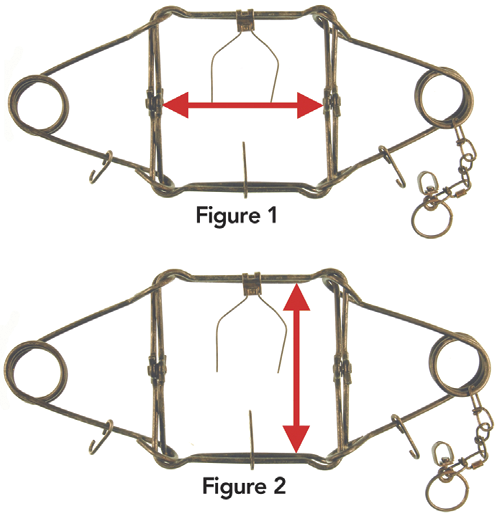
Snares
It is only legal to use a snare to trap a wild animal on land you own or with the written permission of the landowner. The maximum legal circumference for snare loops is 15 inches, unless at least half of the snare loop is covered by water or if the snare employs a relaxing snare lock. A relaxing snare lock allows the snare loop to loosen slightly to reduce the possibility of strangulation. Regulations on snare size and lock are designed to prevent accidental loss of domestic animals.
Box Traps
Furbearers may be captured in box traps used on land or underwater.
Foothold Traps
It is illegal to use a foothold trap with saw-toothed or spiked jaws. It is illegal to take a wild animal with a foothold trap if the widest inside jaw-spread measured perpendicular to the trap’s base plate and the inside width between the trap’s hinge posts (both measurements) is greater than 5¾ inches and less than or equal to 6½ inches, unless the jaws of the trap have at least a 1⁄8-inch offset, the gap of the offset is filled with securely attached rubber pads, or the trap is completely covered by water.
Securely attached rubber pads are those attached with bolts or rivets. The trap’s hinge posts must be maintained at a 90-degree angle to the trap’s base plate. It is illegal to take a wild animal with a foothold trap on land if the widest inside jaw-spread measured perpendicular to the trap’s base plate and the inside width between the trap’s hinge posts is greater than 6½ inches.
It is illegal to set or place a stake, chain, drag, or another portion of a trap that is designed to take a wild animal, except during a season established for trapping that wild animal.
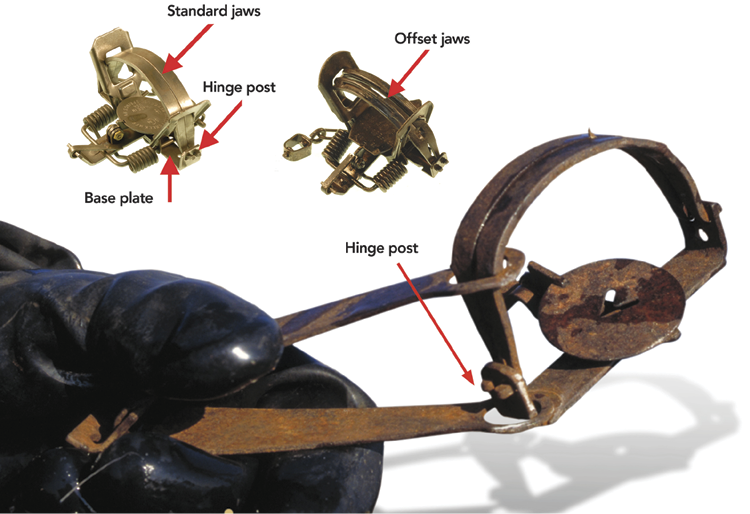
Measuring Your Foothold Trap
- Measure the widest inside jaw spread perpendicular to the trap’s base plate as in Figure 3 and circle the measurement (or closest measurement) in Column 1.
- Measure the inside width between the trap’s hinge posts as in Figure 4 and circle the measurement (or closest measurement) in Column 2.
- If both measurements fall in Box 1, then the trap can have standard jaws (offset jaws are not required).
- If either measurement falls in Box 2, then the jaws of the trap must have at least a 1⁄8 inch offset or the gap of the offset can be filled with securely attached rubber pads. “Securely attached” means with bolts or rivets, not tape.
- If either measurements fall in Box 3, then the trap must be completely covered by water.
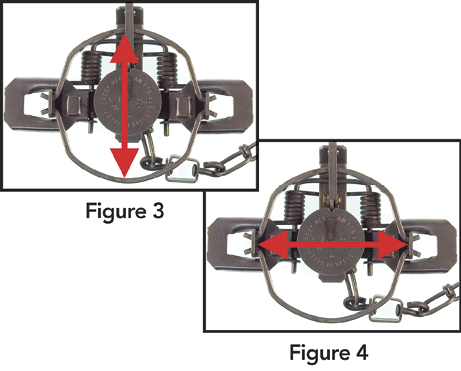
Box |
Column 1 |
Column 2 |
1 |
5 inches or less |
5 inches or less |
5¼ inches |
5¼ inches |
|
5½ inches |
5½ inches |
|
5¾ inches |
5¾ inches |
|
2 |
5¾ inches or more |
5¾ inches or more |
6 inches |
6 inches |
|
6¼ inches |
6¼ inches |
|
6½ inches |
6½ inches |
|
3 |
6½ inches or more |
6½ inches or more |
6¾ inches |
6¾ inches |
|
7 inches |
7 inches |
|
7¼ inches or more |
7¼ inches or more |

